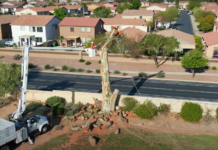Eva Eleene Sullivan moved to Arizona when she was only three months old. The family took the train from Arkansas to Prescott searching for possible work at the VA Hospital located there in 1918. The Sullivan family was most grateful to escape the 1918 influenza outbreak during this period of time.
When Eleene was two years old, her family moved to the Maricopa and Casa Grande area where they homesteaded in 1920. Eleene and her siblings began their school years at the little schoolhouse in Summerland that was Stanfield’s first school (White and Parker & Barnes Roads). The children attended this school for six years, and then the family left the Maricopa area.
In 1948 Eleene and her husband, Bill Green, returned to Maricopa with their two children, nine-year-old Shirley and eleven-year-old Larry. Eleene said that it was after the war and jobs were hard to find. “Bill loved farming, but didn’t have the money to start a farming business. However, he had done electrical work in the military and was just completing the necessary papers to go to Guam as an electrician with a friend of his when he heard about this farming opportunity down in the Maricopa area.”
He made the necessary connections with a man by the name of Leroy Kleck, who owned a piece of land down in the El Centro (Maricopa Road & Miller Road at that time) area south of Maricopa. Later, Miller Road was changed to Louis Johnson Road. Kleck told Bill there was a little farmhouse that they could live in if they wanted it….but not to expect much.
Eleene remembers, “I had just gotten out of the hospital at the time, but was excited at the opportunity to have Bill at home and working at something he loved….farming. The farmhouse sounded just fine with me, but, on the way out to Maricopa, Bill warned me not to expect too much, “Babe, it’s not much of a house, but a chance for us to do something.”
Her answer reflected the true pioneer spirit of her time, and the love she had for her husband. She said, “Bill, I don’t care if I have to live under a mesquite tree if that will keep you home.” They arrived under the cover of darkness to witness what would become their home for the next 16 years: a rough little farmhouse with nothing else.
Her daughter, Shirley, moaned, “Oh, Mom, I want to go home!” However, her son, Larry, saw only amazing adventures exploring the mysterious desert as he began to unload his bicycle off the truck.
According to Eleene, “Thus began the best years of our lives out in the middle of nowhere with few amenities, but renewed hope for a family life.”
During the following years Bill worked 16 hours a day and seven days a week. The only day he took off was Christmas Day. Kleck paid him $250 per month, and, after they settled their doctor and hospital bills, they had about $80 a month to live on. Even though, in the beginning, it was difficult, they managed to get by. The first year Bill share-leased the land from Kleck, but that was the only year he worked for him. The second year Kleck leased the land to Bill, and the banks were happy to work with him for future farming needs. Bill Green ended up with 1,050 acres and some of the most successful crops in the area during his farming years in Maricopa.
According to Eleene, the arch nemesis of the farmer in the Maricopa-Stanfield area was the dreadful Johnson grass. Neighboring farmers told Bill they had never been able to control it. Bill figured man could control most things if the right solution was applied. His strategy was to dig deep; to do that, he secured a heavy-duty plough and a crawler to turn the soil. Thus, the depth had conquered the Johnson grass and future cotton crops flourished. Besides cotton, Bill was equally successful with growing acres and acres of maize and alfalfa.
Later, Bill started a herd of Black Angus cattle and was able to buy a few of CP Honeycutt’s quarter horses purchased from King’s Ranch in Texas. Eleene said he ended up owning 16 quarter-horses that they took to Colorado with them when they moved in 1964.
Where did they shop for the items not grown on their farm? They bought some of their groceries at the grocery store in the Maricopa Hotel (and later the Maricopa Mercantile) or in Casa Grande. Once a week, they took the farm workers in the back of their pick-up to Maricopa or to Casa Grande to meet up with friends, buy groceries or whatever. The deadline for returning to the truck to travel back to the farm was 9 p.m., and everyone had to be back at that time….if they wanted a ride home.
Eleene remembers one time she needed to use the old crank phone located outside of the Maricopa Hotel (south of RR tracks from 1931-1954), but she couldn’t get it to work. It was the only phone in the area as far as she knew. Anyway, she had to go into the hotel to get someone to come out and help her use it.
Bill’s brother, Albert, came to Arizona with the family (Green Road) and eventually got a job working for Bill Miller who lived south of them. Joe Machado bought a farm on Papago Road and hired Bill’s other brother, John, as his foreman. John moved a house from the Phoenix area down to the farm and worked for Machado for many years. Eleene said this was the happiest time of her life. She had all of her family living nearby, or in the near vicinity of her, and even though life was rough in the beginning, it was a most happy time.
Their children went to Stanfield School, and they had the privilege of knowing many of the farming families in the Maricopa and Stanfield area. They went to square dances and school functions. Eleene reminisces about the good neighbors and friends, but credits her family and extended family as being most responsible for the happiness of this period of their life. This 90 plus-year-old great-great grandmother laments the “Nuclear Family” of today where one of them goes one way and the other goes another way. “Those years hold so many wonderful memories and happy times for me.”
The worst thing that happened to her was when their house burned down and they lost almost everything. She was able to grab a few of their pictures. They had 25 cycle electricity, and the electric stove and refrigerator were just too much for it. The house caught fire. Eleene said it went too fast to put it out. They were not only out in the cold, but had lost all their clothes, furniture and everything.
The people of Stanfield immediately gave them a shower that included everything they needed in the house except for clothes. They were most grateful for such kindness and generosity. The family lived in the shop on the farm for some time until they could build a new house. The shop had no plumbing or anything. Eventually, their new house was finished, and life was good.
Bill passed away years ago, but today Eleene Green (92 years old) lives close to her grandson, Scott Green, in Taylor, Texas.
Photo courtesy of the Maricopa Historical Society
Editor’s note: Maricopa factoids are a regular feature on InMaricopa.com. They are provided by the Maricopa Historical Society, a branch of the Friends of the Maricopa Public Library. Most information comes from “Reflections of a Desert Town” by author and historical society chairperson Patricia Brock.
Gift Cards are available for Brock’s the new book: “Images of America: Maricopa” along with a short story of Maricopa. Contact Brock at 480-821-0604 or [email protected] to purchase a gift card or to reserve a copy of the book.



![Shred-A-Thon to take place tomorrow An image of shredded paper. [Pixabay]](https://www.inmaricopa.com/wp-content/uploads/2024/03/shredded-paper-168650_1280-218x150.jpg)













![Shred-A-Thon to take place tomorrow An image of shredded paper. [Pixabay]](https://www.inmaricopa.com/wp-content/uploads/2024/03/shredded-paper-168650_1280-100x70.jpg)
